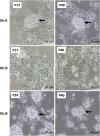Continuous cell lines derived from the Asian citrus psyllid, Diaphorina citri, harbor viruses and Wolbachia
- PMID: 39747462
- PMCID: PMC11696443
- DOI: 10.1038/s41598-024-83671-2
Continuous cell lines derived from the Asian citrus psyllid, Diaphorina citri, harbor viruses and Wolbachia
Abstract
The Asian citrus psyllid, Diaphorina citri Kuwayama (Hemiptera: Liviidae), is a major pest of global citriculture. In the Americas and in Asia, D. citri vectors the phloem-limited bacterium, Candidatus Liberibacter asiaticus (CLas), which causes the fatal citrus disease huanglongbing, or citrus greening. Cell lines derived from D. citri can provide insight into both the basic biology of this pest and D. citri-associated pathogens including CLas. We previously identified CLG#2 as the optimal medium for long-term growth of D. citri primary cell cultures. Here we report on the establishment and characterization of three continuous D. citri cell lines, Dici1, Dici3, and Dici5, that have been passaged for > 40 times. Based on morphological and transcriptomic data, the Dici1 and Dici3 cell lines include undifferentiated and neurogenic progenitor cells. Dici1 and Dici5 are infected with Wolbachia. Both Dici1 and Dici5 are infected with D. citri reovirus, and Dici5 is also infected with D. citri-associated C virus. Dici3 is free of both Wolbachia and virus infection. These cell lines provide an ideal platform for the study of inter-microbial relationships as well as microbe interaction with host insect cells.
Keywords: Diaphorina citri; Wolbachia; Asian citrus psyllid; Citrus greening disease; Insect cell line; Transcriptome.
© 2024. The Author(s).
Conflict of interest statement
Competing interests: The authors declare no competing interests.
Figures




Similar articles
-
Distribution and Variation of Bacterial Endosymbiont and "Candidatus Liberibacter asiaticus" Titer in the Huanglongbing Insect Vector, Diaphorina citri Kuwayama.Microb Ecol. 2019 Jul;78(1):206-222. doi: 10.1007/s00248-018-1290-1. Epub 2018 Nov 24. Microb Ecol. 2019. PMID: 30474731
-
Detection of Wolbachia (Rickettsiales: Anaplasmataceae) and Candidatus Liberibacter asiaticus (Rhizobiales: Rhizobiaceae) Associated With Diaphorina citri (Hemiptera: Liviidae) Collected From Citrus reticulata (Sapindales: Rutaceae) and Alternate Host, Cordia myxa (Boraginales: Boraginaceae).J Econ Entomol. 2020 Jun 6;113(3):1486-1492. doi: 10.1093/jee/toaa043. J Econ Entomol. 2020. PMID: 32207826
-
Optimized conditions for the long-term growth of primary cell cultures derived from the Asian citrus psyllid, Diaphorina citri (Liviidae: Hemiptera).In Vitro Cell Dev Biol Anim. 2023 Apr;59(4):235-240. doi: 10.1007/s11626-023-00765-3. Epub 2023 Apr 21. In Vitro Cell Dev Biol Anim. 2023. PMID: 37084043
-
Diaphorina citri (Hemiptera: Liviidae) Vector Competence for the Citrus Greening Pathogen 'Candidatus Liberibacter Asiaticus'.J Econ Entomol. 2015 Jun;108(3):839-48. doi: 10.1093/jee/tov038. Epub 2015 Mar 21. J Econ Entomol. 2015. PMID: 26470202 Review.
-
Integrated Pest Management Strategies for Asian Citrus Psyllid Diaphorina citri Kuwayama (Hemiptera: Psyllidae) and Huanglongbing in Citrus for Sarawak, East Malaysia, Borneo.Insects. 2022 Oct 20;13(10):960. doi: 10.3390/insects13100960. Insects. 2022. PMID: 36292909 Free PMC article. Review.
References
-
- Bové, J. M. Huanglongbing: A destructive, newly-emerging, century-old disease of citrus. J. Plant Pathol.88, 7–37 (2006).
-
- Halbert, S. E. & Manjunath, K. L. Asian citrus psyllids (Sternorrhyncha: Psyllidae) and greening disease of citrus: A literature review and assessment of risk in Florida. Florida Entomol.87, 330–353 (2004).
-
- Wang, N. & Trivedi, P. Citrus huanglongbing: A newly relevant disease presents unprecedented challenges. Phytopathology103, 652–665 (2013). - PubMed
MeSH terms
Supplementary concepts
Grants and funding
LinkOut - more resources
Full Text Sources

